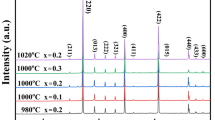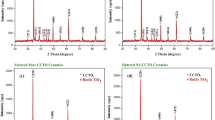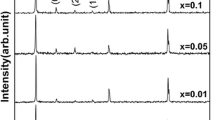Abstract
Calcium manganites (CaMnO3) ceramic powders were prepared by sol–gel technique using citric acid as a chelating agent. The polycrystalline powder crystallized in an orthorhombic structure with lattice parameters a = 5.270 Å, b = 7.421 Å and c = 5.231 Å. Dielectric relaxation was observed which can be attributed to Maxwell–Wagner relaxation behavior. The oxidation states of Calcium, Manganese and the presence of oxygen deficiencies in the prepared samples were ascertained by XPS studies.
Similar content being viewed by others

Avoid common mistakes on your manuscript.
1 Introduction
Perovskite structured materials have gain attraction in technological point of view in various fields of sensors, microwave absorbers, pigments, catalysts, magnetic storage and microelectronics [1]. Perovskite oxides like ATiO3 (A–Ca, Sr) ceramics are promising n-type thermoelectric materials due to the flexibility of doping on both the sites [2]. The AMnO3 (A=Ca, La, Sr, Ba) crystal structure consists of corner sharing octahedral where Mn is surrounded by six oxygen atoms with A locating the cavities [3]. The structure of AMnO3 ceramics makes it feasible for doping of several dopants to tailor its properties [4, 5]. Among them CaMnO3 have gained special attention due to their peculiar structural, thermoelectric, magnetic and electrical properties [3]. Calcium manganite crystallizes in an orthorhombic structure with n-type semiconductor characteristics [6]. The flexibility in the crystal structure of CaMnO3 makes it more feasible for several dopants on both the sites to alter its properties [5]. Calcium manganites possess high thermal conductivity, high Seebeck coefficient and appreciable electrical conductivity [5]. The variation of oxygen content in calcium manganites over a broad range makes it a potential candidate as cathode in solid oxide fuel cells [7]. CaMnO3 possess superior thermoelectric properties like high Seebeck coefficient and low values of electrical conductivity which makes it a promising material for thermoelectric applications [6]. Several synthesis techniques like solid-state reaction [8], chemical coprecipitation method [9], electrostatic spray deposition [10], gas phase reaction synthesis [11], soft chemistry synthesis [12] were adapted to prepare CaMnO3 ceramics. Herein we have synthesized CaMnO3 by sol–gel technique to achieve a homogeneous sample with uniform particle size, morphology and high crystallinity. The dielectric behavior of CaMnO3 have not been extensively analyzed; this thrived our interest to carryout dielectric measurements at higher temperatures and herein we report about the dielectric relaxation present in the prepared CaMnO3 sample.
2 Experimental methods
Adopting sol–gel technique CaMnO3 ceramics have been prepared using citric acid as a chelating agent. The initial precursors Calcium nitrate (Ca(NO3)3·4H2O), and Manganese nitrate (Mn(NO3)3·4H2O) are taken in stoichiometric ratios and dissolved in deionized water to obtain the homogenous solution. Citric acid solution (C6H8O7) is added drop wise to the homogenous solution and stirred continuously for about 3 h in room temperature. Later the solution is heated up to 80 °C and stirred well until the formation of gel. The obtained gel is dried in a vacuum oven at 120 °C. Further it was pre-sintered at 300 °C in air for 4 h to remove the organic constituents present in it. The final product is obtained after sintering it at 800 °C for 5 h and it is ground into fine powders for further characterizations.
3 Results and discussion
3.1 X-ray diffraction studies
The crystallinity and phase formation of the synthesized material were found by measuring the X-ray diffraction patterns in a 2θ range from 10° to 80° using Bruker D8 advance (Cu Kα radiation, λ = 1.5406 Å). The powder diffraction patterns of CaMnO3 polycrystalline material calcined at 800 °C is shown in Fig. 1. The diffraction patterns revealed that the synthesized material crystallized in an orthorhombic structure (space group Pnma) without any secondary phases. The lattice parameters of the crystalline material were found to be a = 5.270 Å, b = 7.421 Å, c = 5.231 Å and volume found to be 204.577 Å.
3.2 Dielectric studies
The CaMnO3 powder is made into pellets and coated by silver paste for carrying out electrical measurements. The dielectric measurements were carried out in the frequency range 50 Hz to 5 MHz at various temperatures using a LCR meter (HIOKI3532-50LCR meter HITESTER). The variation of dielectric constant with frequency for various temperature ranges are shown in Fig. 2. On increasing the temperature the dielectric constant value increases due to the thermal activation of charge carriers [13]. Due to the presence of space charge polarization and grain boundary effect, the dielectric constant increases at lower frequency regions [14]. At higher temperatures the dielectric constant increases due to the rise of conduction in the prepared sample.
3.3 Impedance studies
The frequency dependence of real part of impedance (Z′) for increasing temperatures are shown in Fig. 3. At lower frequency region, the values of Z′ seems to be constant for all the temperatures due to the accumulation of charge carriers at the electrode interface and grain boundaries. On increasing the frequency and temperature, Z′ values decrease due to the enhancement of conductivity in the prepared material. This phenomena attributes to the behavior of negative temperature coefficient of resistance that usually occurs in semiconducting materials [15, 16].
The frequency dependence of imaginary part of impedance (Z″) for increasing temperatures is shown in Fig. 4. On increasing the temperature, a peak shift is observed toward the higher frequency side which indicates the spreading of relaxation in the material. On increasing the temperature, the Z″ values decrease signifying the existence of thermally activated charge carriers. The presence of temperature-dependent relaxation in the prepared samples were validated by the broadening of peaks [17]. At higher frequencies the accumulation of charges in the electrode interface results in the merging of Z″ [14]. The high-temperature synthesis of oxide ceramics results in the presence of oxygen vacancies which contributes the relaxation phenomenon in the prepared material.
The variation of relaxation time for different temperatures (Arrhenius plot) is shown in Fig. 5, the activation energy is found to be 0.789 eV. The value of activation energy signifies the origin of dielectric relaxation is due to the presence of oxygen vacancies [16].
To analyze the contribution of grain, grain boundary and interfacial effects separately, Nyquist plots for various temperatures are plotted (Fig. 6). On increasing the temperature, depression in the center of semicircle is observed due to the presence of thermally activated conduction process [18].
At lower temperatures, single semicircle is observed which is attributed to the grain conduction mechanism and on increasing the temperature the grain effect is dominated by grain boundary effect. The presence of a semicircle at lower frequencies (Inset of Fig. 6) denotes the existence of space charge polarization effect. From the plot it can be observed that the grain resistance decreases for increasing temperature and the irregular semicircles at higher temperatures may be due to grain boundary stress–strain, grain size distribution, volume fraction and defects in the material [13]. The presence of dielectric relaxations in the prepared samples have resulted in the occurrence of depressed semicircles. Complete semicircles were not observed due to the dominance of electrode polarization effect at lower frequency regions [19]. The frequency dependence of ac conductivity for different temperatures is fitted by Jonscher’s Power law (Fig. 7a). Deviation was observed from the fitting for the lower frequency regions due to domination of electrode polarization effect. The activation energy for obtained from the Arrhenius fit (Fig. 7b) is found to be 0.898 eV. The activation energy value attributes to the oxygen vacancies, localized ions and hopping of electrons present in the material [20, 21].
3.4 XPS studies
The oxidation state of the Calcium, Manganese and presence of oxygen vacancies was confirmed by carrying out XPS studies. The XPS survey spectra (Fig. 8a) for the synthesized CaMnO3 ceramics reveal the presence of Ca, Mn, O and C without any other impurity peak. The two Mn 2p peaks (Fig. 8b) corresponding to Mn2P3/2 and Mn2P1/2 are centered around 643 eV and 655 eV, respectively. Both the peaks seem to be asymmetric and contains an additional peak which corresponds to the presence of Mn4+, this confirms the presence of oxygen vacancies in the prepared samples [22]. The reduction of Mn4+ to Mn3+ ions are related to the oxygen vacancies present due to the oxygen vacancies as a consequence of high-temperature sintering. The charge neutrality is maintained by the following mechanism [23]:
The XPS spectra for Ca2p are shown in Fig. 8c, the peak centered around 346 eV and 349.5 eV corresponds to Ca2P1/2 and Ca2P3/2, respectively [24].
4 Conclusions
Ceramic powders of CaMnO3 were synthesized by sol–gel technique using citric acid as chelating agent. The synthesized material crystallized to an orthorhombic structure. Maxwell–Wagner relaxation were observed in the dielectric measurements for temperature ranges between 373 and 573 K. The presence of electrode polarization effect was observed in the Nyquist plot and in conductivity measurements. The existence of Mn3+ and Mn4+ states for manganese is confirmed by XPS studies which clearly evident the presence of oxygen vacancies in the prepared samples.
References
T. Herranz, S. Rojas, M. Ojeda, F.J. Pérez-Alonso, P. Terreros, K. Pirota, J.L.G. Fierro, Synthesis, structural features, and reactivity of Fe–Mn mixed oxides prepared by microemulsion. Chem. Mater. 18(9), 2364–2375 (2006)
J.W. Fergus, Oxide materials for high temperature thermoelectric energy conversion. J. Eur. Ceram. Soc. 32(3), 525–540 (2012)
F.P. Zhang, X. Zhang, Q.M. Lu, J.X. Zhang, Y.Q. Liu, Electronic structure and thermal properties of doped CaMnO3 systems. J. Alloys Compd. 509(10), 4171–4175 (2011)
W.S. Tan, H.P. Wu, K.M. Deng, X.S. Wu, Q.J. Jia, J. Gao, Studies on strain relaxation and in-plane orientation of La0.7Ca0.3MnO3 film by grazing incidence X-ray diffraction. J. Alloys Compd. 491(1–2), 545–549 (2010)
D.H. Manh, P.T. Phong, T.D. Thanh, L.V. Hong, N.X. Phuc, La0. 7Ca0.3MnO3 perovskite synthesized by reactive milling method: the effect of particle size on the magnetic and electrical properties. J. Alloys Compd. 491(1–2), 8–12 (2010)
S.D.O. Torres, D. Thomazini, G.P. Balthazar, M.V. Gelfuso, Microstructural influence on thermoelectric properties of CaMnO3 ceramics. Mater. Res. (2020). https://doi.org/10.1590/1980-5373-mr-2020-0169
M. Schrade, R. Kabir, S. Li, T. Norby, T.G. Finstad, High temperature transport properties of thermoelectric CaMnO3–δ—indication of strongly interacting small polarons. J. Appl. Phys. 115(10), 103705 (2014)
N. Pandey, A.K. Thakur, R.N.P. Choudhary, Studies on Dielectric Behaviour of an Oxygen Ion Conducting Ceramic—CaMnO3-δ (CSIR, Chennai, 2008).
J. Lan, Y.H. Lin, H. Fang, A. Mei, C.W. Nan, Y. Liu et al., High-temperature thermoelectric behaviors of fine-grained Gd-doped CaMnO3 ceramics. J. Am. Ceram. Soc. 93(8), 2121–2124 (2010)
K. Fujimoto, M. Gibu, Y. Yamaguchi, A. Aimi, K. Nishio, O. Rabin, I. Takeuchi, Thermoelectric properties of bismuth-substituted calcium manganite Ca1−xBixMnO3−δ prepared via the electrostatic spray deposition method. J. Ceram. Soc. Jpn. 125(4), 308–312 (2017)
K. Koumoto, Y. Wang, R. Zhang, A. Kosuga, R. Funahashi, Oxide thermoelectric materials: a nanostructuring approach. Annu. Rev. Mater. Sci. 40, 363–394 (2010)
L. Bocher, M.H. Aguirre, R. Robert, D. Logvinovich, S. Bakardjieva, J. Hejtmanek, A. Weidenkaff, High-temperature stability, structure and thermoelectric properties of CaMn1−xNbxO3 phases. Acta Mater. 57(19), 5667–5680 (2009)
L.S. Lobo, S. Kalainathan, A.R. Kumar, Investigation of electrical studies of spinel FeCo2O4 synthesized by sol–gel method. Superlattices Microstruct. 88, 116–126 (2015)
K.R. Nandan, A.R. Kumar, Electrical properties of Ca0.925Ce0.075Mn1−xFexO3 (x = 0.1–0.3) prepared by sol–gel technique. J. Mater. Sci. Mater. Electron. 27(12), 13179–13191 (2016)
N. Kumari, V. Kumar, S.K. Singh, Structural, dielectric and magnetic investigations on Al 3+ substituted Zn-ferrospinels. RSC Adv. 5(47), 37925–37934 (2015). https://doi.org/10.1039/C5RA03745J
L.S. Lobo, A.R. Kumar, Investigation of structural and electrical properties of ZnMn2O4 synthesized by sol–gel method. J. Mater. Sci. Mater. Electron. 27(7), 7398–7406 (2016). https://doi.org/10.1007/s10854-016-4714-z
L.S. Lobo, A.R. Kumar, Structural and electrical properties of ZnCo2O4 spinel synthesized by sol–gel combustion method. J. Non-Cryst. Solids 505, 301–309 (2019). https://doi.org/10.1063/1.4794349
S.G. Mohamed, C.J. Chen, C.K. Chen, S.F. Hu, R.S. Liu, High-performance lithium-ion battery and symmetric supercapacitors based on FeCo2O4 nanoflakes electrodes. ACS Appl. Mater. Interfaces 6(24), 22701–22708 (2014). https://doi.org/10.1021/am5068244
G. Murugesan, R. Nithya, S. Kalainathan, Colossal dielectric behaviour of Sr2TiMnO6−δ single crystals. J. Cryst. Growth 530, 125179 (2020)
L.S. Lobo, A.R. Kumar, Investigation on structural and electrical properties of FeMnO3 synthesized by sol–gel method. Ionics 25(3), 1341–1350 (2019). https://doi.org/10.1007/s11581-018-2776-z
S. Yuvaraj, V.D. Nithya, K.S. Fathima, C. Sanjeeviraja, G.K. Selvan, S. Arumugam, R.K. Selvan, Investigations on the temperature dependent electrical and magnetic properties of NiTiO3 by molten salt synthesis. Mater. Res. Bull. 48(3), 1110–1116 (2013). https://doi.org/10.1016/j.materresbull.2012.12.001
B. Zhang, A. Chang, Q. Zhao, H. Ye, Y. Wu, Synthesis and thermoelectric properties of Yb-doped Ca0.9−xYbxLa0.1MnO3 ceramics. J. Electron. Mater. 43(11), 4048–4055 (2014)
S. Jaiswar, K.D. Mandal, Evidence of enhanced oxygen vacancy defects inducing ferromagnetism in multiferroic CaMn7O12 manganite with sintering time. J. Phys. Chem. C 121(36), 19586–19601 (2017)
L. He, G. Dong, C. Deng, Effects of strontium substitution on the phase transformation and crystal structure of calcium phosphate derived by chemical precipitation. Ceram. Int. 42(10), 11918–11923 (2016)
Author information
Authors and Affiliations
Corresponding author
Additional information
Publisher’s Note
Springer Nature remains neutral with regard to jurisdictional claims in published maps and institutional affiliations.
Rights and permissions
About this article
Cite this article
Nandan, K.R., Lobo, L.S., Murugesan, G. et al. Dielectric relaxation in CaMnO3 ceramics synthesized by sol–gel method. J Mater Sci: Mater Electron 33, 8355–8360 (2022). https://doi.org/10.1007/s10854-021-06185-x
Received:
Accepted:
Published:
Issue Date:
DOI: https://doi.org/10.1007/s10854-021-06185-x











